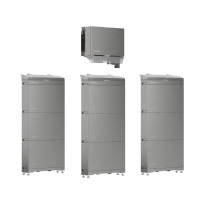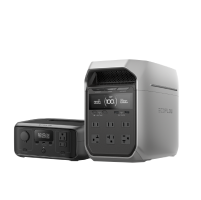How Efficient Is Air Source Heating?
With increasing energy bills and a stronger push to sustainable living, UK homeowners are now looking for smarter heating systems. Air source heating offers a better way to cut costs while also reducing carbon emissions.
In this guide, we’ll explore how air source systems work, how efficient they are, how much power they consume, and how much they cost.
What Is Air Source Heating?
Air source heating works by extracting heat from the outside air to warm your home and heat up your water, even if temperatures drop to -15°C. This system typically has two main types: air-to-air systems that circulate warm air through rooms, and air-to-water systems, like EcoFlow PowerHeat, which heat radiators, underfloor systems, and even water.
These systems are actually ideal for UK homeowners who want a low-carbon alternative to standard electric, gas, or oil heating, without compromising heating performance and reliability.
How Does Air Source Heating Work?
This system works by absorbing heat from the outside air by using an evaporator. A refrigerant inside the heat pump compresses the absorbed heat to raise its temperature even more, then transfers it to your home through underfloor heating, radiators, or hot water tanks.
The efficiency of an air source system is typically measured by the Coefficient of Performance (COP). For instance, a COP of 2.5-4.5 means 1 kWh of electricity generates about 3-4 kWh of heat.
It’s also measured by another metric called Seasonal COP (SCOP), which tracks efficiency figures more accurately than COP alone. For UK winters, SCOP averages around 3.2, making air source systems highly efficient, which benefits homeowners who need long-term savings.
How Efficient Are Air Source Heat Pumps?
Air source heat pumps are renowned for their efficiency. Their COP/SCOP figures hover between 3 and 4, delivering 300-400% of efficiency, which dominates gas boilers (around 90%) or conventional electric ones (~100%).
With this efficiency, homeowners can save up to £500 in a single year compared to gas heating, depending on home size and usage pattern. But if you compare it with oil or standard electric systems, air source heating offers two primary benefits: environmental and financial.
Its smart design and technology ensure consistent performance in cold winters, without emitting too much carbon, and even rivalling the efficiency of ground-source systems, making it a good choice for homeowners who want to go eco-friendly without breaking their wallets.
Factors Affecting Air Source Heat Pump Efficiency
Though air source systems are highly efficient, there are several factors that influence how efficient it is. Understanding these can help you save energy home and maintain an eco-friendly heating system.

Outdoor Temperature
Colder temperatures naturally reduce system efficiency. At -10°C, an air source heat pump’s COP can drop to around 2.0, in contrast with roughly 4 at a milder 7°C temperature. The reason for this is that the pump needs to work harder to extract heat from the air, which increases power consumption during the chilly UK winters.
Home Insulation
Poorly insulated homes actually lose heat quite quickly, effectively lowering the efficiency of an air source heating system. To combat this, upgrading wall and window insulation can improve your savings by up to 20%, according to Energy Saving Trust.
By investing in better insulation, you can complement the efficiency of an air source system and find yourself shaving pounds after pounds off your energy bill.
System Sizing
Incorrectly sized pumps reduce efficiency, so it’s best to aim for a balance of unit size and your heating demand. For example, oversized pumps tend to short-cycle, leading to wasted energy. On the contrary, undersized ones struggle to meet the heat demand, leading to wasted power too.
With balanced and professional sizing, you can ensure an optimal SCOP rating of around 3.2 for UK conditions, as with PowerHeat’s.
Installation Quality
Poorly installed outdoor units can impede airflow and reduce the performance of your system. To guarantee proper installation and placement, only transact with MSC-accredited installers—plus, you get to avoid voiding your unit’s warranty.
Usage Patterns
Very high output temperatures, like setting radiators to 65°C instead of 45°C, can lower COP figures by as much as 10-15%. Fortunately, this is easy to fix: just choosing a lower heating setting can help the heat pump operate more efficiently.
Maintenance
Just like traditional HVAC systems, heat pumps get efficiency losses of up to 15% if the coils and filters are dirty. Yearly maintenance, which typically costs around £100-150, can keep your heat pump running as it should be, while also maximising its lifespan.
What kind of product or solution are you interested in?


How Much Electricity Does a Heat Pump Use?
An average 3-bedroom UK home uses roughly 2,000-3,000 kWh/year for air source heating systems, according to Energy Saving Trust. However, keep in mind that this is a ballpark figure and actual consumption depends on home size, insulation levels, and temperature settings.
For instance, raising the thermostat just 2°C warmer adds around 15% more power usage. At a typical rate of 20p/kWh (Octopus standard rate, October 2025), this translates to about £400-600/year, which is still significantly cheaper than using traditional electric or oil heaters.
Systems like the PowerHeat are highly efficient, and are designed from the get-go to maximise heating output while keeping power costs manageable and easily trackable. With EcoFlow’s AI-powered HEMS and PowerInsight, you can optimize and manage your home’s heating system to get maximum savings.
Through these management systems, you can also analyze PowerHeat’s and your home’s heating data, and adjust room temperatures and hot water schedules. PowerHeat also comes with an integrated inverted so your home gets constant temperature control for efficient comfort.
Air Source Heating Cost: Installation and Running
Installation costs for air-to-water systems range from £8,000 to £15,000. If you get it with the BUS grant, the upfront investment can drop to about £3,000-8,000, making it more accessible and affordable to the general public.
As for operational costs, running costs sit around £400-600/year, compared to gas, which costs around £900/year, and oil, which costs around £1,200/year. Maintenance costs also remain low, far less than maintaining traditional boilers.
So, in the long term, air source systems literally trump traditional ones by combining affordability, efficiency, and eco-friendliness into one whole package.
Is Air Source Heating Right for You?
If you want to switch to a system that can cut your energy bills further, lower carbon emissions, and you want to enjoy efficient and dependable home heating, air source systems are your best bet.
We suggest assessing your home insulation, getting professional insights, and considering the BUS grant to reduce upfront investment costs. With systems like the PowerHeat, you can rest assured of a reliable, eco-friendly, and efficient warmth all year round.
FAQs
How much electricity does a heat pump use?
The average UK home uses roughly 2,000–3,000 kWh/year for air source heating. Power usage varies with home size, insulation, and thermostat settings. At 20p/kWh, this costs around £400–600 annually. But keep in mind that actual costs fluctuate.
What is the typical cost of air source heating?
Air-to-water installations cost £8,000–15,000. With the BUS grant, prices drop to £3,000–8,000. Running costs average £400–600/year, offering bigger savings compared to gas or oil systems. Considering maintenance, it can add £100-150 a year.
How does air source heating work?
A heat pump extracts warmth from outside air, compresses refrigerant to raise the temperature, and delivers it via radiators, underfloor heating, or hot water. COP is usually 2.5–4.5, giving more heat compared to the electricity used.



